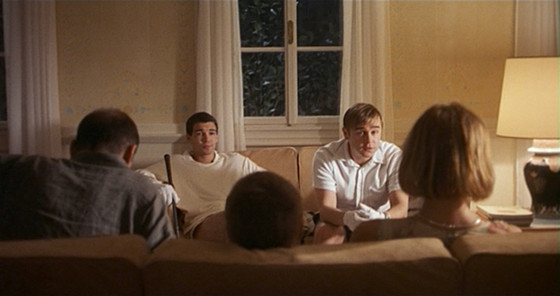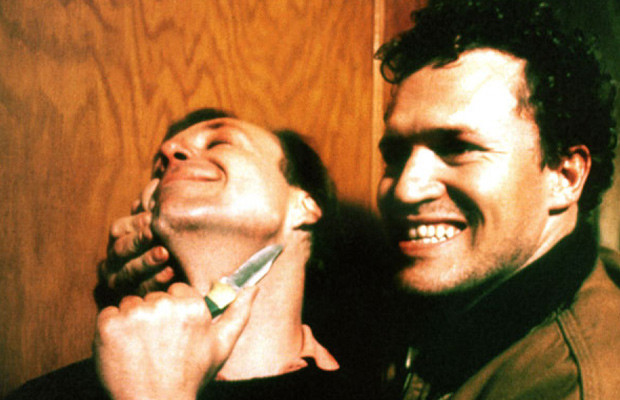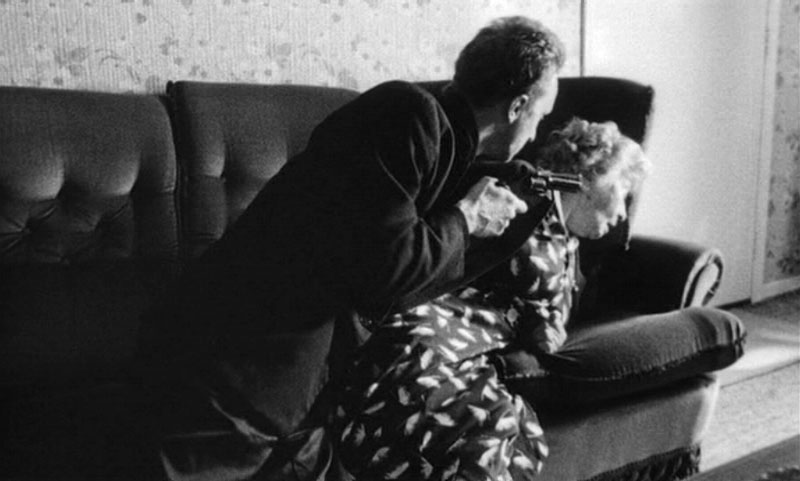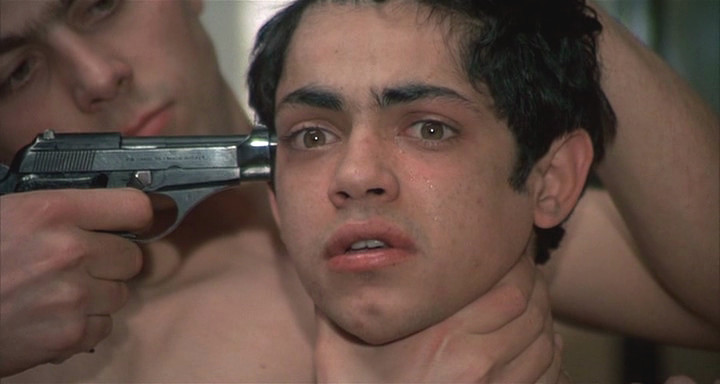6. Funny Games

An upper-class family – George (Ulrich Mühe), Anna (Susanne Lothar) and their son (Stefan Clapczynski) – goes to their small, summer holiday house. After unpacking, they are visited by two mysterious young men – Paul (Arno Frisch) and Peter (Frank Giering), identically dressed in white shirts, white shorts, white shoes and white gloves. The idyll ends when Paul and Peter turn out to be the psychopaths, who – after killing the family’s dog – start to terrorize the whole family with their demented and sadistic psychological games.
The description of plot suggests that the audience will deal with a typical representative of the home invasion/torture porn movie, but this is surely not the case. “Funny Games” – directed by Austrian master of filmmaking and one of the true intellectuals of European cinema, Michael Haneke – is a film like no other.
It’s not only a meta-commentary on typical trophies of American slasher films and their bloodthirsty lovers, but also a depiction of fascination with the evil in mass media. One of the killers, Paul, occasionally breaks the fourth wall – staring, smiling and talking directly to the audience. Close to the movie’s end he even picks up a VCR pilot to rewind the film himself, when the situation with the hostages gets out of his control.
Directed with bold vision and filled with a nihilistic atmosphere of hopelessness, “Funny Games” is a movie that wouldn’t work so effectively if the actors didn’t play their roles so well. Mühe and Lothar are very convincing as the victims, and Frisch (who played a somewhat similar role in an earlier work of Haneke’s, “Benny’s Video”) and Giering are terrifying as emotionless young killers. In 2008, Haneke made a bit unnecessary but still powerful shot-for-shot remake of his own film, this time with English speaking cast: Tim Roth, Naomi Watts and Michael Pitt.
7. Henry: Portrait of a Serial Killer

To take someone’s life means nothing to Henry (Michael Rooker). He chooses his victims randomly, and has no elaborate, intellectual motifs or one specific method to do it, which distinguishes him from the typical Hollywood serial killer. He claims that he killed his abusive mother, but every time he talks about it, he’s changing the details about how he did it, so we don’t really know what the truth is.
Henry lives in a trashy apartment with similarly trashy roommate – ex-convict and marijuana dealer Otis (Tom Towles) – and in the time between murders, he works as a bug exterminator. His life gets complicated when Otis’ sister Becky (Tracy Arnolds) decides to live with them for awhile, and Henry starts an emotional connection with her because they both experienced traumatic childhoods. He also introduces Otis the world of murder and makes him a partner in crime, not knowing that Otis will become even more psychotic and evil than Henry himself.
The movie is directed by John McNaughton, known from “Mad Dog and Glory” (1993) and “Wild Things” (1998), and it’s inspired by the true story of two serial killers – Henry Lee Lucas and Ottis Toole. It is one of the most disturbing and realistic depictions of a serial killer that ever appeared on the cinema screen. While exploring the darkest corner of the human psyche, film remains emotionally cold, just like the eponymous Henry, which gives the feeling of a documentary-like authenticity. There is nothing really glamorous about serial killers and this is the film that really shows it.
Rooker is outstanding in the leading role; his acting abilities make his character fully believable and really creepy. After watching this movie, it’s hard to watch this actor in comedic roles, like in “Mallrats” (1995) or “Guardians of the Galaxy” (2014) and not think about his iconic creation as Henry at the same time. Towles also does a good and memorable job as a redneck Otis. “Henry: Portrait of a Serial Killer” is a truly horrifying film that will absolutely stay in mind long after the final credits disappear from the screen.
8. Man Bites Dog

“Man Bites Dog” is about a group of morally misguided filmmakers who create a documentary about a serial killer named Ben (Benoît Poelvoorde). They follow his steps with their camera, filming the murders he commits and also his pretentious monologues about philosophy of life, art, urban developments, theories about superiority of white race and, above all, what it is to be a serial killer. The filmmakers are soon no longer just the passive spectators of his absolute cruelty, but also start to participate actively in Ben’s murderous rampages.
No other mockumentary is more nihilistic and gruesome than “Man Bites Dog.” The movie form, which imitates a documentary, makes the macabre atrocities committed by Ben become authentic and palpable for the viewer, really getting under one’s skin. “Man Bites Dog” is a satire of the exploitation and glorification of the serial killers in mass media (which somewhat resembles “Natural Born Killers”) and also a comedy that’s black as tar in the moonless night.
The movie was directed by trio of Rémy Belvaux, André Bonzel and Benoît Poelvoorde, who were also the producers, wrote the script and played the leading roles. Benoît Poelvoorde is a real blast as a serial killer Ben – equally scary, pathetic and funny in the same time. “Man Bites Dog” is recommended only for those who are open-minded and can handle the excessive violence mixed with hardcore sardonic humor.
9. Salo, or the 120 Days of Sodom

“Salo, or the 120 Days of Sodom” (1975), directed by Pier Paolo Pasolini, is loosely inspired by the infamous book by Marquis de Sade – “The 120 Days of Sodom, or the School of Libertinage.” In the fascist puppet-state of Salo, four men from the highest level of the social ladder – The Magistrate (Umberto Paolo Quintavalle), The Duke (Paolo Bonacelli), The President (Aldo Valletti) and The Bishop (Giorgio Caproni) – decide to kidnap a group of young teenagers to a villa, purely for their own entertainment.
Worse for the teenagers, the good entertainment, in understanding of those four wicked libertines, is sadism, humiliation, tortures, rape, murder and coprophilia. Soon their villa turns into a slaughterhouse.
The movie is split into four different chapters, each more shocking than the previous one. They’re named (chronologically): Anteinferno (as an intro), Circle of Manias, Circle of Shit, and Circle of Blood, which of course is a reference to Dante’s “Divine Comedy.” It’s one of the most shocking and repulsive films ever made. Sequences of unrestrained, extreme violence and vivid imagery of sexual deviants make this very hard to sit through, but it’s absolutely worth it.
Pasolini wants to shock the audience not only for the sake of making them ill, but rather to make them think. The movie serves an allegory of the totalitarian political system, how it corrupts the minds of those in power, at the same time physically destroying the bodies of those who are underneath them. The four perpetrators of horror don’t even have a seed of remorse for their victims and are fully dedicated to evil with all the possible costs.
At heart, they are simply bored representatives of the bourgeoisie class seeking any kind of excitement. Unfortunately, this was the last film directed by one of the greatest poets of cinema – Pier Paolo Pasolini. He was murdered before “Salo” even appeared in cinemas.
10. The Texas Chainsaw Massacre

The first half of the 70s was a turbulent time for the United States. The trial of Manson’s “Family,” the Vietnam War that was still going on, the ultimate fall of the hippie revolution, the Watergate scandal. “The Texas Chainsaw Massacre,” directed by Tobe Hooper, is a cinematic effect of that era’s social disillusions, just like mold is an effect of moisture. It was also inspired by the shocking case of Ed Gein, who was desecrating graveyards and creating home furniture and clothing from the body parts.
The plot is focused on a group of five friends who arrive to a rural part of Texas to find out if the grave of Sally’s grandfather (Marilyn Burns) and her brother Franklin (Paul A. Partain) didn’t fall victim to desecration, because in this area there were grave robberies, according to a media report.
After checking, they set off further to a cottage that belongs to Sally and Franklin family. Along the way they meet a mentally unstable hitchhiker (Edwin Neal), which is just the beginning of their malicious confrontation with the symbol of the purest evil – a murderous Sawyer family.
“The Texas Chainsaw Massacre” is different from the typical slasher horror movie because it focuses mainly on the atmosphere and leaving things to our imagination, instead of constantly showing us scenes of gory violence. Dirt, filth and decay are omnipresent in every frame of the film. Snuff film-like cinematography and a brooding soundtrack that resembles the musique concrete played in hell are the factors that contribute to the haunting feeling of terror.
One of the representatives of Sawyer family, Leatherface – wearing a mask made of human skin, mumbling and holding a chainsaw – became a recognizable worldwide pop cultural icon. The movie spawned a franchise of sequels and lazy remakes, but only the original one truly makes the audience want to take a shower right afterward. After all these years, it is still so effective in terms of portraying the extreme human evil.